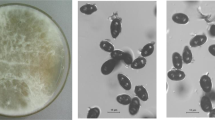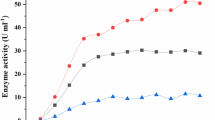Abstract
The capacity of Fusarium sp. strain ZH-H2 to secret lignin peroxidase (LiP), laccase (Lac), and manganese peroxidase (MnP) and degrade high molecular weight polycyclic aromatic hydrocarbons (HMW-PAHs) was studied. When the fungus was grown in control mineral salt medium for 4 days, LiP and Lac activities were detected at 8871 U L−1 and 5123 U L−1, respectively. In the presence of HMW-PAHs as the sole carbon source, only LiP activity was detectable, and LiP activity had significantly reduced HMW-PAHs at day 7, with a maximum decrease of 85.9%. A strong correlation between LiP activity and HMW-PAHs removal efficiency could be fit into various models, with the highest correlation coefficients obtained for quadratic functions (P < 0.01). When a specific enzyme inhibitor was added, the ability of Fusarium to remove HMW-PAHs was reduced from 85.9 to 66.7%, depending on the inhibitor’s concentration. Meanwhile, the determined activity of LiP was reduced from 11.4 to 48.6%. We conclude that in the presence of HMW-PAHs as the only carbon source to support growth, Fusarium ZH-H2 mainly produces LiP but not Lac or MnP for HMW-PAHs degradation. To our knowledge, it was the first time to propose a metabolic lignin peroxidase characterization of HMW-PAHs degradation by Fusarium sp. strains.


Similar content being viewed by others
Change history
28 August 2020
The article Ligninolytic enzyme involved in removal of high molecular weight polycyclic aromatic hydrocarbons by Fusarium strain ZH-H2, written by **aoxue Zhang, **aomin Wang, Cheng Li, Lixiu Zhang, Guohui Ning, Wei Shi, Xuena Zhang and Zhixin Yang, was originally published electronically on the publisher’s internet portal (currently SpringerLink) on 28 July 2020 with open access.
References
Arora DS, Gill PK (2001) Comparison of two assay procedures for lignin peroxidase. Enzyme and Microb Technol 28 (7–8):602–605
Arun A, Eyini M (2011) Comparative studies on lignin and polycyclic aromatic hydrocarbons degradation by basidiomycetes fungi. Bioresour Technol 102:8063–8070
Bezalel L, Hadar Y, Cerniglia CE (1996) Mineralization of polycyclic aromatic hydrocarbons by the white-rot-fungus Pleurotus ostreatus. Appl Environ Microbiol 62:292–295
Chen J (2008) Optimization of conditions for laccase production by white rot fungi and its degradation of polycyclic aromatic hydrocarbons. Master Thesis of Northeast Forestry University
Dash HR, Mangwani N, Chakraborty J, Kumari S, Das S (2013) Marine bacteria: potential candidates for enhanced bioremediation. Appl Microbiol Biotechnol 97:561–571
Dhawale SW, Dhawale SS (1992) Degradation of phenanthrene by Phanerochaete chrysosporium occurs under ligninolytic as well as nonligninolytic conditions. Appl Environ Microbiol 58:3000–3006
Feng CL (2011) Study on degradation and transformation characteristics of lignocellulose by Phanerochaete chrysosporium and its key functional enzymes. Hunan University
Hadibarata T, Kristanti RA (2012a) Fate and cometabolic degradation of benzo[a]pyrene by white-rot fungus Armillaria sp. F022. Bioresour Technol 107:314–318
Hadibarata T, Kristanti RA (2012b) Identification of metabolites from benzo[a]pyrene oxidation by ligninolytic enzymes of Polyporus sp. S133. J Environ Manag 111:115–119
Hadibarata T, Khudhair AB, Salim MR (2011) Breakdown products in the metabolic pathway of anthracene degradation by a ligninolytic fungus Polyporus sp. S133. Water Air Soil Pollut 223:2201–2208
Haritash AK, Kaushik CP (2009) Biodegradation aspects of polycyclic aromatic hydrocarbons (PAHs): a review. J Hazard Mater 169:1–15
Hasanin MS, Darwesh OM, Matter IA, El-Saied H (2019) Isolation and characterization of non-cellulolytic Aspergillus flavus EGYPTA5 exhibiting selective ligninolytic potential. Biocatalysis and Agricultural Biotechnology 17:160–167
Hernández-López EL, Perezgasga L, Huerta-Saquero A, Mouriño-Pérez R, Vazquez-Duhalt R (2016) Biotransformation of petroleum asphaltenes and high molecular weight polycyclic aromatic hydrocarbons by Neosartorya fischeri. Environ Sci Pollut Res 23:10773–10784
Kaya F, Heitmann JA, Joyce TW (2000) Influence of lignin and its degradation products on enzymatic hydrolysis of xylan. Biotechnology 80:241–247
Lee H, Jang Y, Lee YM, Lee H, Kim GH, Kim JJ (2015) Enhanced removal of PAHs by Peniophora and ascertainment of its novel ligninolytic enzyme genes. J Environ Manag 164:10–18
Li X, Wang Y, Wu S, Qiu L, Gu L, Li J, Zhang B, Zhong W (2014) Peculiarities of metabolism of anthracene and pyrene by laccase-producing fungus Pycnoporus sanguineus H1. Biotechnol Appl Biochem 61:549–554
Luisa M et al (1996) Use of laccase for bleaching of pulps and treatment of effluents. Enzym Pulp Paper Process 655:197–206
Mastrangelo G, Fadda E, Marzia V (1996) Polycyclic aromatic hydrocarbons and cancer in man. Environ Health Perspect 104:1166–1170
Meudec A, Poupart N, Dussauze J, Deslandes E (2007) Relationship between heavy fuel oil phytotoxicity and polycyclic aromatic hydrocarbon contamination in Salicornia fragilis. Sci Total Environ 381:146–156
Morgan P, Lewis ST, Watkinson RJ (1991) Comparison of abilities of white-rot fungi to mineralize selected xenobiotic compounds. Appl Microbiol Biotechnol 34:693–696
Novotný C, Erbanova P, Sasek V (1999) Extracellular oxidative enzyme production and PAH removal in soil by exploratory mycelium of white rot fungi. Biodegradation 10:159–168
Peng RH, **ong AS, Xue Y, Fu XY, Gao F, Zhao W, Tian YS, Yao QH (2008) Microbial biodegradation of polyaromatic hydrocarbons. FEMS Microbiol Rev 32:927–955
Peng X, Yuan XZ, Liu H, Zeng GM, Chen XH (2015) Degradation of polycyclic aromatic hydrocarbons (PAHs) by laccase in rhamnolipid reversed micellar system. Appl Biochem Biotechnol 176:45–55
Pickard MA, Roman R, Tinoco R, Vazquez-Duhalt R (1999) Polycyclic aromatic hydrocarbon metabolism by white rot fungi and oxidation by coriolopsis gallica UAMH 8260 laccase. Appl Environ Microbiol 65:3805–3809
Sanglard D, Leisola MSA, Fiechter A (1986) Role of extracellular ligninases in biodegradation of benzo(a) pyrene by Phanerochaete chrysosporium. Enzyme Microb Technol 8:209–211
Schützendübel A, Majcherczyk A, Johannes C (1999) Degradation of fluorene, anthracene, phenanthrene, fluoranthene,and pyrene lacks connection to the production of extracellular enzymes by pleurotus ostreatus and Bjerkandera adusta. Int Biodeterior Biodegradation 43:93–100
Seo JS, Keum YS, Li QX (2009) Bacterial degradation of aromatic compounds. Int J Environ Res Public Health 6:278–309
Sun YKC, Lin Q et al (2013) Determination of polycyclic aromatic hydrocarbons in marine organisms by ultrasonic extraction/gas chromatography-mass spectrometry. J Instrum Anal 32(1):57–63
Sutherland JB, Selby AL, Freeman JP (1991) Metabolism of phenanthrene by Phanerochaete chrysosporium. Appl Environ Microbiol 57:3310–3316
Syed K, Porollo A, Lam YW, Grimmett PE, Yadav JS (2013) CYP63A2, a catalytically versatile fungal P450 monooxygenase capable of oxidizing higher-molecular-weight polycyclic aromatic hydrocarbons,alkylphenols, and alkanes. Appl Environ Microbiol 79:2692–2702
Tien M, Kirk TK (1984) Lignin-degrading enzyme from Phanerochaete chrysosporium: purification, characterization, and catalytic properties of a unique H2O2-requiring oxygenase. Biochemistry 81:2280–2284
Vazquez-Duhalt R, Westlake DW, Fedorak PM (1994) Lignin peroxidase oxidation of aromatic compounds in systems containing organic solvents. Appl Environ Microbiol 60:459–466
Verdin A, Sahraoui AL-H, Durand R (2004) Degradation of benzo[a]pyrene by mitosporic fungi and extracellular oxidative enzymes. Int Biodeterior Biodegradation 53:65–70
Wang Y (2014) Study on the degradation mechanism of P. hemophilus H1 on anthracene and pyrene. Zhejiang University of Technology
Wariishi H, Valli K, Gold MH (1992) Manganese(II) oxidation by manganese peroxidase from the basidiomycete Phanerochaete chrysosporium. Kinetic mechanism and role of chelators. J Biol Chem 267(33):23688–23695
Wirasnita R, Hadibarata T (2016) Potential of the white-rot fungus Pleurotus pulmonarius F043 for degradation and transformation of fluoranthene. Pedosphere 26:49–54
Wu YR, Luo ZH, Vrijmoed LL (2010) Biodegradation of anthracene and benz[a]anthracene by two Fusarium solani strains isolated from mangrove sediments. Bioresour Technol 101:9666–9672
Yuchun C (2008) Isolation and identification of phenanthrene-degrading bacteria and its degradation effect. Zhejiang University of Technology
Zhang XHWX (2010) Determination of 16 polycyclic aromatic hydrocarbons in soil by gas chromatography-mass spectrometry. Rock Miner Anal 31:535–538
Zhang L, Shao X, Han D (2009) Research progress of lignin degrading enzyme system of white rot fungus. Jilin Anim Husb Vet Med 2:9–12
Zhang J, Lin X, Liu WW, Yin R (2012) Response of soil microbial community to the bioremediation of soil contaminated with PAHs. Environ Sci 33:2825–2831
Zhao OY (2015) Study on fungal remediation of starch and earthworm promoting soil high-ration PAHs pollution in coal mining areas. Hebei Agricultural University
Zhu H, Wang HW, Du W, Dai CC (2014) Potential role of the endopytic fungus laccase rLACB3 in the bioremediation of peanut continuous crop** soil. Soil Biol Biochem 33:1920–1927
Funding
This study was supported by Key R&D Program in Hebei Province (19223811D), the National key R&D Program of China (2018YFD0800402), the Educational Commission of Hebei Province of China (Z2013058), and the National High-Tech R&D Program of China (863 Program) (2012AA101403).
Author information
Authors and Affiliations
Corresponding author
Additional information
Responsible Editor: Robert Duran
Publisher’s note
Springer Nature remains neutral with regard to jurisdictional claims in published maps and institutional affiliations.
The original version of this article was revised due to a retrospective open access cancellation.
Rights and permissions
About this article
Cite this article
Zhang, X., Wang, X., Li, C. et al. Ligninolytic enzyme involved in removal of high molecular weight polycyclic aromatic hydrocarbons by Fusarium strain ZH-H2. Environ Sci Pollut Res 27, 42969–42978 (2020). https://doi.org/10.1007/s11356-020-10192-6
Received:
Accepted:
Published:
Issue Date:
DOI: https://doi.org/10.1007/s11356-020-10192-6




